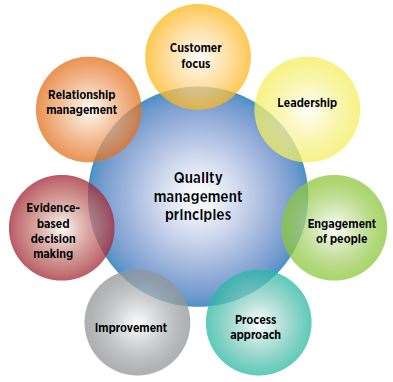“Men of principle are always bold but those who are bold are not always men of principle”-Confucius
Introduction
Principles are very important in life to follow. They are timeless and do not change with time. Like the sun will always rise from the east only, the law of gravity will always work. In our professional life too, there are few principles, if we adhere too, we will always receive predictable results.
Objective
The intent of this article to share about 7 Quality Management Principles, what do they mean, what is their purpose and what benefits an organization can achieve, when implemented effectively.
Detailed Information
The quality Management Principles are not specific to any one industry and can be applied to organizations of any size.
As per ISO 9000: 2015, clause 2.3, following are the 7 principles of Quality Management
- Customer Focus:
It takes months to get a customer and seconds to lose: Vince Lombard
What does it mean?
The prime focus of the organization should be to meet the customer requirements, create more value and enhance their confidence in them.
What is its purpose?
For sustained success, the organization should understand the current and future needs and expectation of the customer and relevant interested parties. Once understood, the key focus should be to not only achieve but continue to strive to exceed them.
What benefits the organization can achieve?
- Increased customer satisfaction and loyalty
- Repeat business
- Enhanced reputation
- Increased revenue and market share
- Leadership:
A leader is the one who knows the ways, goes the way and shows the way: John C. Maxwell
What does it mean?
The key role of leadership is to create unity among all levels of the organization so that everyone can work towards the same objective.
What is its purpose?
For sustained success, Leadership helps to establish a culture of trust and integrity. Leaders at all level of the organization should be able to become a role model for their colleagues, customer and relevant interested parties.
What benefits the organization can achieve?
- Improved effectiveness and efficiency in the processes
- Clarity of the purpose
- Better coordination among different processes
- Engagement of People:
When people are financially invested, they want their return; when people are emotionally invested, they want to contribute: Simon Sinek
What does it mean?
The organization should create a culture where employees at all levels can work together as a team and can add value to their processes.
What is its purpose?
For sustained success, in the organization, there should a culture of openness and transparency so that employees at all levels can work together as a team to achieve the overall objective of the organization.
What benefits the organization can achieve?
- Enhanced development of the people
- Enhanced people satisfaction
- Involvement in improvement activities will improve
- Process Approach:
We should work on the process, not on the outcome of our process: W Edward Deming
What does it mean?
In any organization, the processes are interrelated and interact with each other. For consistent and predictable results, the processes should work in tandem with each other.
What is its purpose?
For sustained success, the organization should understand its interrelated and interacting process and how they can work together to achieve consistent and optimized results.
What benefits the organization can achieve?
- The consistent and predictable outcome
- Confidence to relevant interested parties about the effectiveness and efficiency of their processes
- Improvement:
Strive for continuous improvement rather perfection: Kim Collins
What does it mean?
In any organization, the improvement should be an ongoing process.
What is its purpose?
For sustained success, the organization should not only ensure to maintain its existing performance level but also to adapt themselves as per the changes proposed by interested parties and create new opportunities.
What benefits the organization can achieve?
- Creates a learning environment in the organization
- Creates an environment for innovation
- Enhance ability to predict and change as per ensuing risk and opportunities
- Evidence-Based Decision Making:
It is better to be approximately right than precisely wrong: Warren Buffet
What does it mean?
When the decision is taken based on the facts and discussion, the possibility of getting desired results increases.
What is its purpose?
In the present times, the business is getting more complex and complicated and no one is sure about the right decision. But by using data and analysing with a cross-functional team, the organization can improve the possibility of desired results.
What benefits the organization can achieve?
- Improved decision-making process
- Increases the ability to demonstrate the correctness fo decision taken
- Increase the ability to analyse, question and decide
- Creates an environment for innovation
7. Relationship Management:
What you do not do to yourself, do not do to others: Confucius
What does it mean?
A transparent and warm relationship with all the relevant stakeholders is must for the sustained success of the organization.
What is its purpose?
Any organization’s success is interdependent on its relevant interested parties. The organization should understand their needs and expectation and fulfil them to the best of their ability.
What benefits the organization can achieve?
- Well managed supply chain
- Can create value for the interested parties
Present Challenges:
- How often the organization is focused on understanding the needs and expectation of their customer?
- How often the organization is focused on understanding the issues related to their interested parties?
- How often the decision is based on evidence and not on hunch feeling?
- How often engagement and development of employees are critical for the top management?
References:
ISO 9000: 2015
ISO 9001: 2015
IATF 16949: 2016
This is the 82nd article of this Quality Management series. Every weekend, you will find useful information that will make your Management System journey Productive. Please share it with your colleagues too.
Your genuine feedback and response are extremely valuable. Please suggest topics for the coming weeks.
